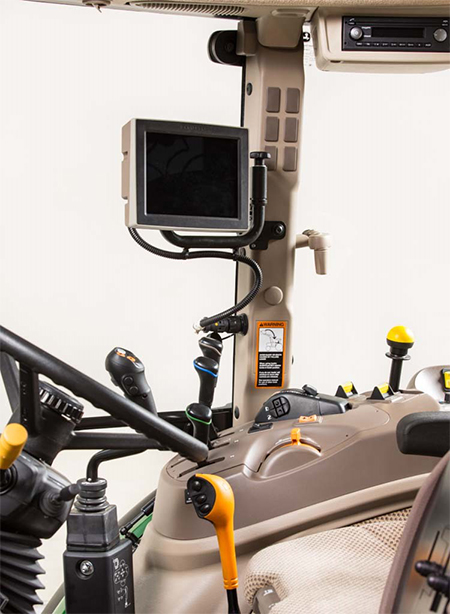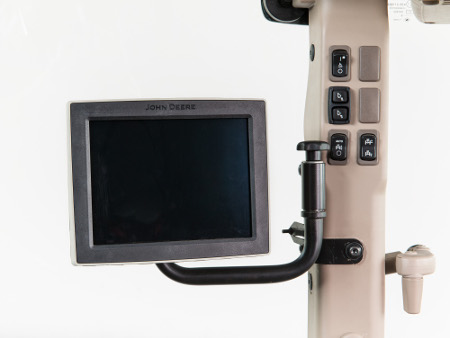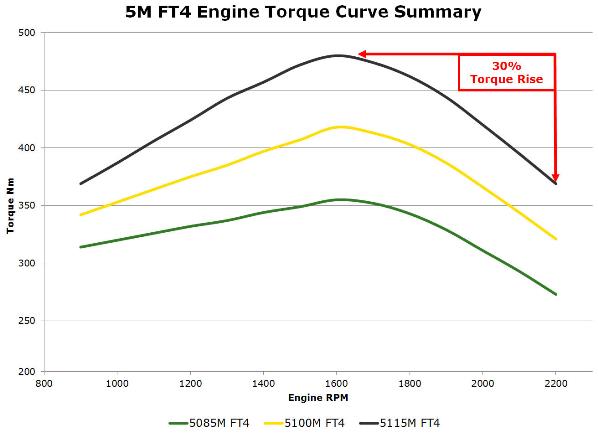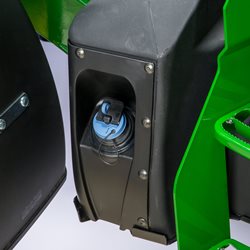
Key Features
- PowrQuad PLUS 16F/16R or Powr8 32F/16R transmission options
- Climate-controlled cab
Hitch lift capacity of 6,970 lbs. with an option of 7,860 lbs.
- Integrated AutoTrac™ guidance
Features
 5M Tractor premium cab with 4240 Universal Display
5M Tractor premium cab with 4240 Universal Display
Overview
The premium cab is designed to provide the ultimate operator experience in comfort and convenience. With the adoption of some 5R Tractor cab structures and features, John Deere has added more technology options, better visibility, and an updated, user-friendly digital display.
Benefits
- Upward visibility has improved 80 percent with the panorama roof in the premium cab, allowing for easier bale stacking, pallet stacking, and dumping loads into walled trailers.
- The rear floor mat behind the seat provides additional storage space.
- The rearview mirror is positioned for excellent visibility to rear operations.
- To shield the operator from the sun, there is an easy to use front sunshade.
 5M Tractor cab with panorama roof
5M Tractor cab with panorama roof
Some of the key features include:
- Deluxe sound package with two 4X6 coaxial speakers and subwoofer
- Factory-installed radio
- Bluetooth® wireless ready
- Satellite ready
- USB port
- Auxiliary cord connection
- Additional heating and cooling vents
- Rear windshield wiper and washer
Bluetooth is a trademark of Bluetooth SIG, Inc.
 Integrated declutch and gear buttons on transmission control lever
Integrated declutch and gear buttons on transmission control lever
The ergonomically placed transmission control allows the operator to change gears and ranging with one simple control. Ranges on the transmission control can be selected by moving the controller in an H pattern. The lever selects ranges A, B, C, or D. Ranges C and D are fully synchronized. That means when upshifting, operators can move from range C to D without stopping the tractor. On the downshift, operators can move from D all the way to B without stopping
- PowrQuad PLUS transmission can be ordered 16 forward speeds and 16 reverse speeds with four manually shifted ranges and four electronically shifted speeds in each range.
- Powr8 transmission can be ordered 32 forward speeds and 16 reverse speeds with four manually shifted ranges and eight electronically shifted speeds in each range. Additionally, ECO Shift offers a top speed of 40 km/h (25 mph) with reduced engine rpm in the two highest gears.
- Two buttons (a rabbit or turtle indicator) allow operators to gear up (rabbit) or gear down (turtle) within a range.
- A range change can be made with a simple press of the declutch button rather than using the foot clutch.
- Eliminates wear on the clutch
- Reduces steps to change gears by 35 percent, resulting in improved efficiencies
PowrQuad PLUS and Powr8 transmissions offer great value for producers looking for a more productive transmission in a mid-spec utility tractor.
 AutoTrac in the tractor display
AutoTrac in the tractor display
5M Tractors can be ordered with AutoTrac integrated in the tractor display.
AutoTrac is a great solution if you are looking for a lower-cost integrated guidance system for your utility tractor. For the straight track only feature, you will no longer need an additional display or display activation. When a 5M Utility Tractor is ordered with AutoTrac Ready (code 182D), the AutoTrac screen is included; all you need to add is a StarFire™ 6000 Receiver (code 1881).
Benefits of AutoTrac on the tractor display:
- Simple and user friendly
- Total cost of integrated AutoTrac is 36 percent lower by eliminating the need for a precision ag display
- Reduces startup costs with no display activation or subscription fees
- Reduces operator fatigue
- Eliminates implement overlap and optimizes machine efficiency
5M Tractors can also be factory equipped with a 4240 Universal Display (code 190M) that transitions AutoTrac guidance from the tractor display to the Gen 4 4240 Universal Display for additional capabilities:
- On-screen mapping
- Documentation
- Section Control
 Gen 4 4240 Universal Display
Gen 4 4240 Universal Display
NOTE: Once the 4240 is disconnected, the tractor display is re-activated.
 5M Tractor digital dash display
5M Tractor digital dash display
The digital display in the center console has three liquid crystal displays (LCDs) to make it even easier to operator your 5M Tractor. The reconfigurable display can be navigated with buttons located on the right-hand side of the console. The display allows the operator to view tractor functions and make changes on the go for better machine monitoring and comfort in the field.
- View diagnostic trouble code (DTC) text on the display
- Entry-level guidance within the dash with AutoTrac™ assisted steering system
- Ability to customize tractor functions
- Adjustment of reverser modulation
 Navigation buttons for display
Navigation buttons for display
On the right side of the console in green are a check mark button used to select items, a left arrow button that serves as a back button, and a menu button. The black wheel in the center is used for toggling within screens or adjusting settings.
In addition to displaying machine information, the digital display also serves as the primary interface between the tractor and operator when adjusting hitch, transmission, hydraulic, and engine settings.
 5M Tractor 3-point hitch
5M Tractor 3-point hitch
Overview
Heavy-duty 3-point hitch provides lift capacity and adjustability for implement versatility with Category 2 implements or adaptable to Category 1. Precisely raise and lower heavy implements such as planters, sprayers, and field cultivators, using the rockshaft control lever. The operator can also adjust the speed at which an implement is lowered by adjusting the rockshaft rate of drop.
Benefits
- Convenience hooking up implements with telescoping draft links, adjustable sway bars, and interchangeable hitch balls with the choice of either mechanical or electrohydraulic controls.
- Consistency when lowering hitch with depth stop on both mechanical and electrohydraulic hitch controls - each time the position control lever is pushed forward, it stops where the depth stop has been positioned. Useful when preparing a seedbed.
- Compatible with implements needed to perform multiple jobs. Increased lift capacity is available with optional larger cylinders. See Specifications for lift capacity by model.
- Convenience when leveling implements with right lift link being able to adjust without tools - lift links can be adjusted for lateral float to allow implements with gauge wheels or skids to follow the ground contour
Additional details
Mechanical or electrohydraulic hitch control operation
Raise and lower rear implements with precision with either the mechanical or electrohydraulic (EH) hitch control. The operator can also adjust the speed at which an implement is lowered by adjusting the rockshaft rate of drop.
The mechanical hitch control is paired with the tractors equipped with a PowrReverser™ transmission while the EH hitch control is paired with units equipped with a PowrQuad™ PLUS or Powr8™ transmission. Both control types enable the operator to adjust the speed at which an implement can be lowered by adjusting the rockshaft rate of drop. In addition to this feature, the EH hitch control adds repeatable movements by enabling the operator to set both an upper and lower limit.
The adjustable depth stop (found on both control types) provides consistency when lowering the hitch. Each time the position control lever is pushed forward, it stops where the depth stop has been positioned. This feature is a value to anyone who desires a consistent, level ground, like when preparing a seedbed.
The center link can be set in one of three positions to accurately set the implement position and draft sensing. The right lift link is adjustable without tools for added convenience when leveling implements.
Optional larger cylinders:
Transmission |
Cylinder diameter |
Lift capacity at 610-mm (24-in) behind lift point |
PowrReverser™ transmission models |
Two 65-mm (2.56-in.) cylinders |
See specifications for lift capacity. |
PowrReverser models with optional high-capacity hitch |
One 65-mm (2.56-in.) cylinder |
|
PowrQuad PLUS or Powr8 transmission models |
Two 75-mm (2.95-in.) cylinders |
|
PowrQuad PLUS or Powr8 models with optional high-capacity hitch |
Two 80-mm (3.15-in.) cylinders |
Rear fender hitch controls
 5M rear fender hitch controls
5M rear fender hitch controls
Operators do not need to carry a tool to adjust the rear hitch. Operators can also raise and lower the 3-point hitch from outside of the tractor with the conveniently located rear fender hitch controls.
Rear quick hitch
 Rear quick hitch
Rear quick hitch
 Sideview of quick hitch shown on 5M
Sideview of quick hitch shown on 5M
An updated three-point quick hitch is offered on the 5M Tractors.
- This updated design is a break from the existing welded quick hitch as the frame is cast.
- The curved design eliminates the potential for contact with the rear fender and extensions.
- The quick hitch is available as a field kit option.
Sway bars
 5M Tractor sway bars
5M Tractor sway bars
Adjustable sway bars and telescoping draft links can be easily adjusted to adapt to a wide variety of implements. The right lift link also adjusts without tools for added convenience when leveling implements.
5M Final Tier 4 (FT4) engines feature up to a 4 percent power bulge when put under load. The power bulge feature of the electronically controlled engine delivers additional horsepower as engine rpm drops below rated speed. Additionally, a 30 percent torque rise provides the force that maintains horsepower as engine rpm drops below rated speed.
When the tractor is under load, power bulge and torque rise work together to get through the tough spots without having to downshift. Horsepower and torque are mathematically related.
 |
As rpm drops, the only way to maintain or increase horsepower is to provide additional torque. The output horsepower is greater than or equal to rated horsepower as the engine is pulled down to 1750 rpm.
The peak torque rise also occurs near the rated economy power take-off (EPTO) speed.
 5M power curve summary
5M power curve summary
 5M torque curve summary
5M torque curve summary
A heavy tractor means more down force to keep implements in the ground. More weight also leads to improved traction and performance in the field. Because the 5M is made with heavy and durable cast steel, it weighs enough to power through those tough jobs.
The compactness of the 5M Series regarding wheelbase, weight, and total height tractor makes this tractor suited for a variety of different applications and is the perfect choice for all types of farms.
A heavy tractor also means better stability when performing loader work. Transport full bucket loads faster and lift bales higher with a stronger and more stable base.
 Tractor weight package
Tractor weight package
Model |
5090M |
5100M |
5115M |
5125M |
MFWD cab |
3950 kg (8700 lb) |
4040 kg (8900 lb) |
4040 kg (8900 lb) |
4175 kg (9185 lb) |
The U.S. Environmental Protection Agency (EPA) and Environment Canada requires all off-road diesel engines with 18.6 kW (25 hp) or more to meet stringent FT4 emissions regulations. John Deere uses the most efficient and cost-effective solution for the tractor package to meet emissions requirements at each horsepower level. The 5M delivers a hassle-free emissions solution that allows faster work and operation with ease.
The engine powering the 5M is EPA certified Tier Level 4. This is achieved through a combination of a diesel oxidation catalyst (DOC) and selective catalytic reduction (SCR) using diesel exhaust fluid (DEF, or urea).
Several defining features on the 5M maximize the performance and reliability of the emissions package. A completely shielded DOC/SCR not only protects essential components from damage, it also keeps out dirt and debris. The well-packaged and tightly organized circulation system means there is more room to work around the tractor.
 PowerTech™ PWL Final Tier 4 technology
PowerTech™ PWL Final Tier 4 technology
Key components of the emissions system include:
DOC
John Deere has chosen to utilize an exhaust filter to reduce particulate material so the engine can operate at a level which produces less NOx. With less NOx created, less DEF is required to treat. The result is improved total fluid economy (diesel and DEF).
The engine is programmed to aggressively respond to changes in power needs, which can temporarily increase particulate matter. Since the exhaust filter removes particulate matter instead of the engine, the engine is left free to do what it is designed to do – deliver all of the power, torque, plus transient response needed.
DEF
DEF is an ISO 22241 standard aqueous urea solution consisting of 32.5 percent urea and has a freezing point of -11°C (12°F). A heated DEF tank keeps the customer in the field longer even when the temperatures drop below freezing. The DEF tank header is integrated with a temperature sensor, and plumbed engine coolant lines are used to promote thawing and prevent freezing in the tank during operation.
 DEF tank
DEF tank
Mounted near the DEF tank, the electronic control unit (ECU)-controlled supply module draws diesel exhaust fluid from the storage tank and provides a pressurized flow to the dosing module. When the ignition key is off, the supply module pump will reverse direction to return any accumulated fluid back to the tank. The supply module is also fitted with a replaceable filter to prevent contaminants from entering the dosing lines. Both the supply module and dosing lines are electrically heated and controlled by the ECU to determine when DEF dosing can begin.
The dosing module is cooled by engine coolant and used to inject DEF at a pressure of 9 bar (900 kPa, 130 psi) into the decomposition tube. A harness is connected to the dosing valve that relays the needed DEF to inject based upon the amount of NOx exiting the DOC measured from the NOx tube sensor.
The decomposition tube is the internal mixing device used to circulate DEF with engine exhaust prior to entering the SCR/AOC after-treatment device.
SCR
To reduce the NOx, DEF is injected into the exhaust stream. When the exhaust gases combine with the DEF in the SCR catalyst, the NOx is broken down into nitrogen and water vapor.
 SCR location on the 5M Tractor
SCR location on the 5M Tractor
Exhaust gas recirculation (EGR)
EGR reduces the high temperatures where these compounds are formed in the engine cylinders by replacing excess oxygen with a prescribed amount of cooled exhaust gas.
Exhaust gases contain more carbon dioxide than oxygen. The EGR valve, in conjunction with the venturi tube, and engine control unit (ECU), allow a controlled amount of exhaust gas to enter the intake manifold to mix with the incoming fresh air.
Replacing excess oxygen with cooled exhaust gas leads to:
- Lower combustion temperatures, creating less NOx.
In addition, EGR allows for:
- Advanced timing
- Optimal engine performance
- Maximum fuel economy
For added performance and efficiency, the engine passes the exhaust gases through an EGR cooler before it enters the engine.
Exhaust airflow enters the EGR cooler from the exhaust manifold near the turbocharger. Based on engine load, air temperatures, and rpm, the ECU opens or closes the EGR valve, allowing a measured percentage of exhaust gas to enter the intake manifold. The gases mix with the rest of the incoming air from the turbocharger and aftercooler before entering the cylinders.
Series turbochargers
The PowerTech PWL 4.5L (274.6-cu in.) engine utilizes one turbocharger — a fixed geometry turbocharger. Fresh air is first drawn into the low-pressure fixed geometry turbocharger and compressed to a higher pressure. The compressed air is then routed to the charge air cooler and then to the intake manifold.
Benefits of air-to-air aftercooling
- Lowers the intake manifold air temperature
- Provides more efficient cooling while reducing temperatures for greater engine reliability
- Higher volume of air flows into the cylinders
- Engine can meet the increasing horsepower demands
Combustion process with externally cooled EGR
Functions:
- According to engine operating conditions, the recirculated exhaust gases reduce the oxygen portion in the intake air to approximately 20 percent. Without any increase of the charge air pressure, the oxygen rate is not high enough to ensure a complete combustion of the fuel injected at high engine loads.
Advantages:
Fuel-efficient combustion is achieved because sufficient oxygen is provided.
A restrained, cooler combustion is realized, since the typical hot combustion process, which is generated by an oxygen surplus, is dampened by the inert exhaust gases. Hence, NOx emissions are reduced.
For more information regarding EPA regulations and the technology behind John Deere Integrated Emissions Control systems, please visit the following link:
http://www.deere.com/wps/dcom/en_US/campaigns/ag_turf/emissions/final_tier_4.page
Promotions
Key Specs
| Engine description | John Deere PowerTech™ PWL |
| Engine displacement | 4 cylinders: 4.5 L 276 cu in. |
| Rated engine power | At 2100 per ISO 97/68/EC: 75 kW 101.45 hp |
| Maximum engine power | |
| Rated PTO power (hp SAE) | At 2100 per SAE: 63 kW 85 PTO hp |
| Maximum PTO power | |
| Transmission type | Standard: 16F/16R PowrReverser™ Optional: 12F/4R SyncShuttle™ Plus 32F/16R PowrReverser Plus |
| Hydraulic pump rated output | 94 L/min 24.7 gpm |
| Rear hitch category (SAE designation) | Category 2; convertible to 1 |
| Base machine weight |
Engine specifications
| Description | John Deere PowerTech PWL |
| Engine type | |
| Engine family | LJDXL04.5315 |
| Rated speed | |
| Aspiration | Turbocharged/air-to-air aftercooled |
| Cylinders liners | Wet sleeved |
| Emission level | Final Tier 4 |
| After treatment type | |
| Displacement | 4 cylinders: 4.5 L 276 cu in. |
Engine performance
| Rated power | At 2100 per ISO 97/68/EC: 75 kW 101.45 hp |
| Rated PTO power (hp SAE) | At 2100 per SAE: 63 kW 85 PTO hp |
| Maximum PTO power | |
| Intelligent Power Management (IPM) | |
| Power boost | |
| Maximum engine power | |
| Engine peak torque | |
| Drawbar power | |
| PTO torque rise | At 1600 rpm: 30 percent |
| Fuel injection system and control | |
| Air cleaner type |
Transmission
| Type | Standard: 16F/16R PowrReverser Optional: 12F/4R SyncShuttle Plus 32F/16R PowrReverser Plus |
| Reverser | Left hand, mechanical |
| Clutch; wet/dry | Wet |
| Creeper | 32F/16R PowrReverser |
Hydraulic system
| Type | Open center |
| Pump rated output | Standard: 94 L/min 24.7 gpm |
| Available flow at a single rear SCV | 70 L/min 18.4 gpm |
| Available flow at front SCVs | |
| Number of rear selective control valves (SCVs) | Two, up to three total |
| Number of mid selective control valves (SCVs) | Two, up to three total |
| Number of front selective control valves (SCVs) | |
| Joystick SCV control | Standard |
| Auxiliary hydraulic features | |
| SCV control |
Rear hitch
| Hitch draft control load sense type | Mechanical or electrohydraulic |
| Remote control valves available | Standard: Two Optional: Three |
| Hitch category (SAE designation) | Category 2; convertible to 1 |
| Maximum lift capacity behind lift points | Standard: 2578 kg 5685 lb Optional: 2993 kg 5954 lb |
| Lift capacity at standard frame | |
| Sensing type | Lower link |
| Rear axle differential lock | Electrohydraulic |
Drawbar
| Drawbar category | |
| Maximum vertical load |
Rear power take-off (PTO)
| Type | Standard: Independent 540/540 Economy Optional: 540/540E/1000 |
| Engine rpm (at rated PTO speeds) | 540 at 2100 rpm 540E at 1645 rpm |
| Economy PTO speeds | |
| Reverse PTO speeds | |
| Multispeed PTO option availability | |
| Ground speed PTO option availability | |
| PTO actuation | Electrohydraulic |
Front hitch
| Category | Category 2 |
| Electric power | |
| Standard lift capacity | 1931 kg 4257 lb |
| Front power take-off (PTO) | |
| PTO speed |
Rear axle
| Type | |
| Final drive type | Inboard planetary |
| Differential controls | Electrohydraulic |
| Axle type | Flanged |
| Brakes, type and control | Hydraulic wet disc |
| Rear differential lock | |
| Load rating |
Front axle
| Type | |
| Front axle differential lock | |
| Load rating |
Tires
| Front | 2WD: 11L-15 8PR F2 Firestone MFWD: 320/85R24 (12.4R24) R1W Radial Firestone |
| Rear | 2WD: 460/85R30 (18.4R30) R1W Firestone® MFWD: 460/85R30 (18.4R30) R1W Firestone |
| Wheel tread range | 2WD: front: 1520-2020 mm 59.8-79.5 in. rear: 1349-2055 mm 53.1-80.9 in. MFWD: front: 1299-1997 mm 51.1-78.6 in. |
| Turning radius with brakes | 2WD: 3.67 m 12.04 ft MFWD: 3.85 m 12.6 ft |
| Turning radius without brakes | 2WD: 3.85 m 12.6 ft MFWD: 4.0 m 13.1 ft |
| Central Tire Inflation System (CTIS) |
Tracks
| Tread spacing | |
| Drive type | |
| Track width | |
| Midrollers |
Steering
| Type |
Brakes
| Primary brake (foot brake) | |
| Secondary brake | |
| Park lock | |
| MFWD braking | |
| Front axle brakes | |
| Auxiliary brakes | |
| Hydraulic trailer brakes | |
| Pneumatic trailer brakes |
Electrical system
| Alternator size | |
| Battery options | |
| Working lights | |
| Type of bulb in headlight (Halogen, Zenon, LED) | |
| Type of bulb in beacon (Halogen, Zenon, LED) | |
| dB(A) rating for backup alarm | |
| Total cold cranking amps |
Operator station
| Rollover protective structure, OOS | Rigid - foldable - telescopic Foldable, two-post Platform - flat/straddle Flat Gearshift location - console/floor Floor |
| Seat | Standard: Mechanical suspension Optional: air ride |
| Cab suspension | |
| Instructional seat | Optional |
| Display | |
| Radio | Optional |
| Inner cab volume | |
| dB(A) rating | 78 dBA |
| Cab glass area | |
| Safety glass rating | |
| Front visibility |
Dimensions
| Wheelbase | 2WD and MFWD: 2350 mm 92.5 in. |
| Overall width | |
| Overall length | |
| Overall height | |
| Drawbar clearance | |
| Front axle center | |
| Approximate shipping weight, Open;Cab | 2WD: Open: 3700 kg 8410 lb Cab: 3900 kg 8580 lb MFWD: Open: 3975 kg 8765 lb Cab: 4175 kg 9185 lb |
Weight
| Base machine weight | |
| Maximum ballast level | |
| Maximum permissible weight |
Capacities
| Crankcase oil volume | |
| Fuel tank | Standard: Open: 111.9 L 29.6 U.S. gal. Cab: 139.1 L 36.7 U.S. gal. Optional: Open: 141.2 L 37.3 U.S. gal. Cab: 170.3 L 45 U.S. gal. |
| Diesel exhaust fluid (DEF) tank | 12.1 L 3.2 U.S. gal. |
| Cooling system | |
| Transmission-hydraulic system |
Serviceability
| Interval for engine oil change | |
| Interval for hydraulic/transmission oil change | |
| Interval for engine coolant change |
Loaders
| Loader | |
| Lift capacity at full height | |
| Maximum lift height | |
| Leveling type |
Precision AG
| Guidance | |
| Telematic | |
| Remote diagnostics |
Miscellaneous
| AutoTrac ready | |
| ISOBUS ready | |
| CommandCenter video inputs | |
| Immobilizer | |
| Side slope rating | |
| Uphill/downhill slope rating | |
| Country of manufacture | Augusta, GA |
Additional information
| Date collected | 8/10/2017 |

